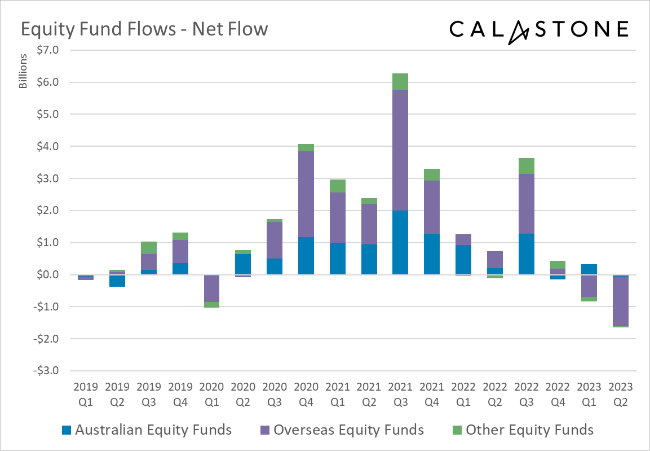Investors are fleeing equity funds. Here's where they're going instead
Investors are yanking their capital from equity funds in favour of fixed income and cash, according to the latest Fund Flow Index from Calastone.
Calastone’s Fund Flow Index tracks capital from advisers and platforms as it flows into and out of managed funds.
Across all fund types, outflows netted out at $2.80 billion in Q2, representing the worst quarter since records began almost 5 years ago. It’s also the first time Calastone recorded net outflows in two consecutive quarters, after Q1 saw $151 million leave equity funds.
In this wire, I break down the findings and add an additional perspective from a leading wealth manager - Charlie Viola, partner and managing director at Pitcher Partners.
Equities
Equity funds suffered the greatest capital flight, with $1.65 billion pulled between April and June.
Most of this net outflow was seen in global equity funds, which lost $1.52 billion.
Of that total net outflow, ESG equity funds made up $508 million. ESG funds have now experienced outflows for five consecutive months. To put that in perspective, ESG funds had only experienced outflows in two of the preceding 24 months.
Aussie equity funds, meanwhile, were left relatively unscathed with net outflows of just $59 million.
.png)
“Global equity funds have borne the brunt of outflows as investors are losing confidence in the prospects for the global economy,” observes Teresa Walker, Managing Director of Australia and New Zealand at Calastone.
While Australia’s outflows have been relatively muted, the fundamentals don’t leave it immune to the same pain felt globally.
"The RBA has hiked rates aggressively to tamp down inflation and is content to generate Australia’s first recession in a generation (barring the initial Covid-19 shock) if it is necessary to achieve its ends."
"In the short term, banks, which dominate the ASX, benefit from rising interest margins, but recessions are costly for banks too if non-performing loans increase, so there is no particular reason to favour the Australian market more than those elsewhere at present."
The only equity funds in the green were those invested in emerging markets, with inflows of $4 million.
Fixed income and cash
With equity markets expensive and the macro picture dark, investors are flying to safety.
"Short-dated fixed income funds currently enable investors to earn an income of 4.4% or more at very low risk. Meanwhile the 10-year Australian bond yield has jumped from 3.1% to 4.0%."
Fixed income funds saw net inflows over the quarter of $582 million, and $1.25 billion year to date.
And while the index doesn't reflect the money market, the difference between equity fund outflows and fixed income inflows can be at least partly attributed to a move to cash.
"Cash savings rates are also at their most tempting in years – with some deposit accounts offering as much as 5%. Investors are content to sit on the sidelines and take the interest."
The rest
With the possible exception of consumer spending, property is typically the first casualty of a rate hiking cycle. And this is borne out in Calastone's data, with outflows of A$173m.
"The yield gap between most types of commercial property and the short-end of the yield curve has largely disappeared over the last year as central banks have raised interest rates and property prices are falling," says Walker.
"That leaves property offering no compensation for additional recession risk.”
Meanwhile, mixed asset funds, which tend to be heavily weighted towards equities saw record quarterly outflows of A$544m.
Dry powder
The relative good health of equity markets and the sickness evident in the real economy makes for an odd marriage.
"It remains an odd period, where we have seen markets rise, but sentiment be reasonably muted," says Charlie Viola, partner and managing director at Pitcher Partners.
"The talk of all the risks continues to dominate, which is why we are seeing investors maybe pairing back their equity exposures. There remains lots of talk of the impending Q3 and Q4 rate cliff, where we see fixed rates and low mortgage rates turn into much larger repayment requirements for home owners. This will have an impact on consumption."
For Viola, the move from mainstream equities is indicative of the view that markets look expensive right now, so investors are looking for returns in non-correlated ways.
The current price of markets, coupled with the anticipated earnings downgrades, also speaks to the need for a bit of deployable dry powder.
"If we start to head into and earnings period and we start to see some weakness, investors will be disappointed if they don’t have some capital to deploy into that weakness.
"We would also be happily taking a little bit of value right now. But, that’s not to say we are wholesale selling stuff. We view risks by the risk of impairment, not the risk of volatility, so while we want some moneys available for weakness, in the main, we want to stay invested and continue to generate revenue through the cycle."

